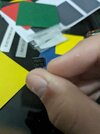I've built this in my breadboard and it doesn't work the same as the video shows. It is much less sensitive. The voltage given by the first potentiomete to pin 5 by any colour (red green yellow) is about 4.7v and one led to the right, however whenever i put black on the sensor it drops to 1.1v and no led turns on. Showing it a dark brown gives about 1.9v and it opens a led on the left.
I read that there was no way a cny70 could detect colors in a post from here on 2004.
Any help is greatly appreciated. I've already brought this problem to reddit and we came to the conclusion that there was a problem with the sensor circuit but it is exactly the same as androbot, except that i have a cny70 tfk 136 and he had a tfk 102.
I read that there was no way a cny70 could detect colors in a post from here on 2004.
Any help is greatly appreciated. I've already brought this problem to reddit and we came to the conclusion that there was a problem with the sensor circuit but it is exactly the same as androbot, except that i have a cny70 tfk 136 and he had a tfk 102.



